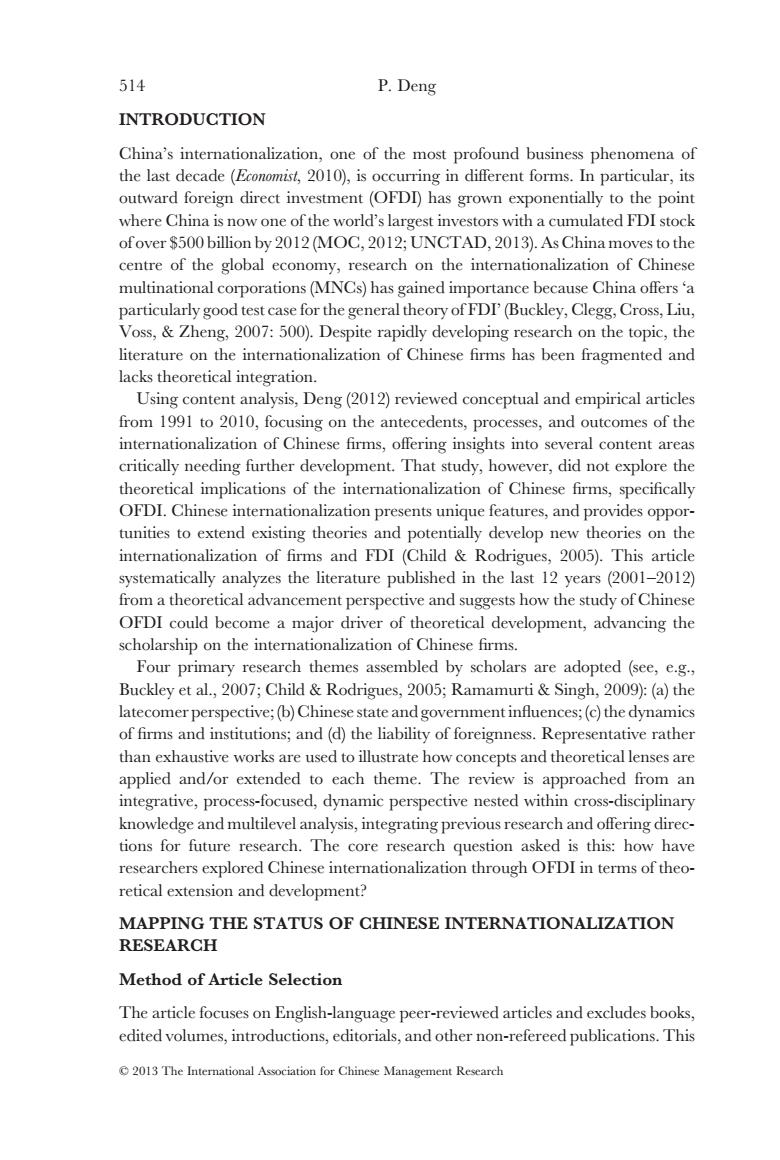正在加载图片...

514 P.Deng INTRODUCTION China's internationalization,one of the most profound business phenomena of the last decade (Economist,2010),is occurring in different forms.In particular,its outward foreign direct investment(OFDI)has grown exponentially to the point where China is now one of the world's largest investors with a cumulated FDI stock ofover S500billion by 2012(MOC.2012:UNCTAD.2013).As Chinamoves to the centre of the global economy,research on the internationalization of Chinese multinational corporations (MNCs)has gained importance because China offers particularly good test case for the general theory of FDI(Buckley,Clegg,Cross,Liu. Voss,Zheng,2007:500).Despite rapidly developing research on the topic,the literature on the internationalization of Chinese firms has been fragmented and lacks theoretical integration Using content analysis,Deng(2012)reviewed conceptual and empirical articles from 1991 to 2010,focusing on the antecedents,processes,and outcomes of the internationalization of Chinese firms,offering insights into several content areas critically needing further development.That study,however,did not explore th theoretical implications of the internationalization of Chinese firms,specifically OFDI.Chinese internationalization presents unique features,and provides oppor- tunities to extend existing theories and potentially develop new theories on the systematically analyzes the literature published in the last 12 years (2001-2012) from a theoretical advancement perspective and suggests how the study of Chinese OFDI could become a major driver of theoretical development,advancing the scholarship on the internationalization of Chinese firms. Four primary research themes assembled by scholars are adopted (see.e.g. Buckley et al.,2007;Child Rodrigues,2005;Ramamurti Singh,2009):(a)the omer perspective;(b)Chin of firms and institutions;and(d)the liability of foreignness.Representative rather than exhaustive works are used to illustrate how concepts and theoretical lenses are applied and/or extended to each theme.The review is approached from an integrative,process-focused,dynamic perspective nested within knowledge and multilevel analysis.integrating previous research and offering direc- tions for future research.The core research question asked is this:how have researchers explored Chinese internationalization through OFDI in terms of theo retical extension and development? MAPPING THE STATUS OF CHINESE INTERNATIONALIZATION RESEARCH Method of Article Selection The article focuses on English-language peer-reviewed articles and excludes books, edited volumes,introductions,editorials,and other non-refereed publications.This 2013 The International Asociation for Chinese Management ResearchINTRODUCTION China’s internationalization, one of the most profound business phenomena of the last decade (Economist, 2010), is occurring in different forms. In particular, its outward foreign direct investment (OFDI) has grown exponentially to the point where China is now one of the world’s largest investors with a cumulated FDI stock of over $500 billion by 2012 (MOC, 2012; UNCTAD, 2013). As China moves to the centre of the global economy, research on the internationalization of Chinese multinational corporations (MNCs) has gained importance because China offers ‘a particularly good test case for the general theory of FDI’ (Buckley, Clegg, Cross, Liu, Voss, & Zheng, 2007: 500). Despite rapidly developing research on the topic, the literature on the internationalization of Chinese firms has been fragmented and lacks theoretical integration. Using content analysis, Deng (2012) reviewed conceptual and empirical articles from 1991 to 2010, focusing on the antecedents, processes, and outcomes of the internationalization of Chinese firms, offering insights into several content areas critically needing further development. That study, however, did not explore the theoretical implications of the internationalization of Chinese firms, specifically OFDI. Chinese internationalization presents unique features, and provides opportunities to extend existing theories and potentially develop new theories on the internationalization of firms and FDI (Child & Rodrigues, 2005). This article systematically analyzes the literature published in the last 12 years (2001–2012) from a theoretical advancement perspective and suggests how the study of Chinese OFDI could become a major driver of theoretical development, advancing the scholarship on the internationalization of Chinese firms. Four primary research themes assembled by scholars are adopted (see, e.g., Buckley et al., 2007; Child & Rodrigues, 2005; Ramamurti & Singh, 2009): (a) the latecomer perspective; (b) Chinese state and government influences; (c) the dynamics of firms and institutions; and (d) the liability of foreignness. Representative rather than exhaustive works are used to illustrate how concepts and theoretical lenses are applied and/or extended to each theme. The review is approached from an integrative, process-focused, dynamic perspective nested within cross-disciplinary knowledge and multilevel analysis, integrating previous research and offering directions for future research. The core research question asked is this: how have researchers explored Chinese internationalization through OFDI in terms of theoretical extension and development? MAPPING THE STATUS OF CHINESE INTERNATIONALIZATION RESEARCH Method of Article Selection The article focuses on English-language peer-reviewed articles and excludes books, edited volumes, introductions, editorials, and other non-refereed publications. This 514 P. Deng © 2013 The International Association for Chinese Management Research